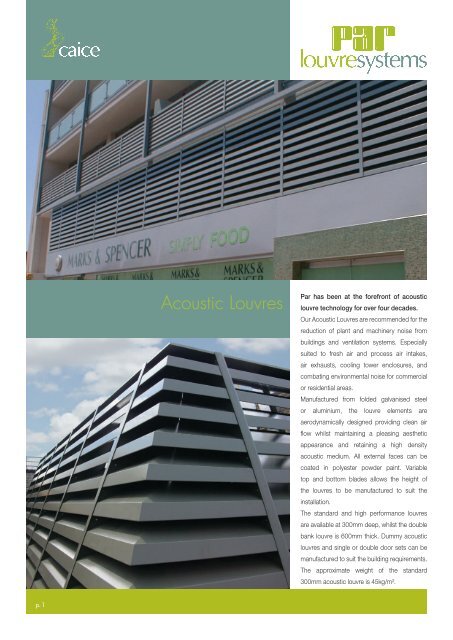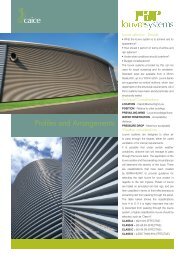Acoustic Louvre brochure - Caice
Acoustic Louvre brochure - Caice
Acoustic Louvre brochure - Caice
You also want an ePaper? Increase the reach of your titles
YUMPU automatically turns print PDFs into web optimized ePapers that Google loves.
<strong>Acoustic</strong> <strong>Louvre</strong>s<br />
Par has been at the forefront of acoustic<br />
louvre technology for over four decades.<br />
Our <strong>Acoustic</strong> <strong>Louvre</strong>s are recommended for the<br />
reduction of plant and machinery noise from<br />
buildings and ventilation systems. Especially<br />
suited to fresh air and process air intakes,<br />
air exhausts, cooling tower enclosures, and<br />
combating environmental noise for commercial<br />
or residential areas.<br />
Manufactured from folded galvanised steel<br />
or aluminium, the louvre elements are<br />
aerodynamically designed providing clean air<br />
flow whilst maintaining a pleasing aesthetic<br />
appearance and retaining a high density<br />
acoustic medium. All external faces can be<br />
coated in polyester powder paint. Variable<br />
top and bottom blades allows the height of<br />
the louvres to be manufactured to suit the<br />
installation.<br />
The standard and high performance louvres<br />
are available at 300mm deep, whilst the double<br />
bank louvre is 600mm thick. Dummy acoustic<br />
louvres and single or double door sets can be<br />
manufactured to suit the building requirements.<br />
The approximate weight of the standard<br />
300mm acoustic louvre is 45kg/m².<br />
p. 1
Design Notes<br />
1. The above table is a theoretical and the<br />
actual louvre height should be used to<br />
determine the number of airways.<br />
2. The ‘No. off Airways’ gives the number<br />
of Active airways, where each airway is<br />
110mm high.<br />
3. Actual Free Area (m²) =<br />
No. off airways x 0.11 x (width mm - 50)<br />
1000<br />
4. The Actual Free Area is the Minimum<br />
Free Area at the front face and will<br />
increase towards the rear of the louvre.<br />
5. The Free Area range indicates the<br />
percentage free area for the smallest -<br />
greatest height louvre within the height<br />
limits.<br />
Standard <strong>Acoustic</strong> <strong>Louvre</strong> - Als<br />
Calculated Free Area<br />
<strong>Louvre</strong> Height No. Off Free Area<br />
(mm) Airways Range %<br />
535 - 734 1 14% - 20%<br />
735 -934 2 13% - 29%<br />
935 -1134 3 28% - 34%<br />
1135 -1334 4 32% - 37%<br />
1335 -1534 5 33% - 39%<br />
1535 - 1734 6 36% - 41%<br />
1735 - 1934 7 38% - 42%<br />
1935 - 2134 8 39% - 43%<br />
2135 - 2334 9 40% - 44%<br />
2335 - 2534 10 41% - 45%<br />
2535 - 2734 11 42% - 45%<br />
2735 - 2934 12 43% - 46%<br />
2935 - 3134 13 43% - 46%<br />
Sound reduction Index<br />
The <strong>Acoustic</strong> <strong>Louvre</strong> performance is derived<br />
from independent laboratory tests carried<br />
out in accordance with BS2750 Part3-1980<br />
(ISO 140 Part 111-1978), and indicated on the<br />
table below.<br />
Standard <strong>Acoustic</strong> <strong>Louvre</strong> ALS<br />
Frequency (Hz): 63 125 250 500 1k 2k 4k 8k<br />
S.R.I (dB): 4 5 10 12 15 23 21 24<br />
High Performance <strong>Acoustic</strong> <strong>Louvre</strong> HPALS<br />
Frequency (Hz): 63 125 250 500 1k 2k 4k 8k<br />
S.R.I (dB): 5 6 12 15 18 28 31 28<br />
Double Bank <strong>Acoustic</strong> <strong>Louvre</strong> DBALS<br />
Frequency (Hz): 63 125 250 500 1k 2k 4k 8k<br />
S.R.I (dB): 6 8 12 18 24 26 20 18<br />
p. 2
200<br />
150<br />
1<br />
Pressure Loss Pa. N/m2<br />
50<br />
40<br />
30<br />
20<br />
Without Birdmesh<br />
With Birdmesh<br />
Pressure Drop And Weather<br />
Protection<br />
The optimum selection of any weather louvre<br />
is a balance of pressure drop and degree of<br />
10<br />
weather protection or water rejection.<br />
Percentage Efficiency<br />
200<br />
90<br />
80<br />
5<br />
1 2 3 4 5 6 7 8<br />
Effective Face Velocity m/sec<br />
70<br />
60<br />
50<br />
40<br />
30<br />
20<br />
10<br />
0<br />
0.5 1 1.5 2 3 4<br />
2<br />
0 mph wind speed<br />
30 mph wind speed<br />
Normally the process of selection will follow<br />
these steps:<br />
(i) Knowing the pressure loss acceptable,<br />
Graph 1 gives the limiting face velocity required<br />
for a louvre with or without a Birdmesh screen.<br />
(ii) The percentage effectiveness of water<br />
reflection can be checked from Graph 2 at 0<br />
and 30 mph (13 m/sec) wind speeds.<br />
(iii) Graph 3 will allow the dimensions of the<br />
louvre to be estimated when Effective Face Area<br />
has been calculated from :<br />
Eff. Face Area = Volume of air flow m3/sec<br />
Eft. Face Velocity m/sec<br />
Note that the normal height selection ceases at<br />
500mm. Below this height Par engineers should<br />
be consulted for an optimum design.*<br />
10<br />
9<br />
Effective Face Velocity m/sec<br />
3<br />
8<br />
2400H<br />
Effective Face Area is<br />
Effective Face Area m 2<br />
7<br />
6<br />
5<br />
4<br />
3<br />
2<br />
1<br />
2200H<br />
2000H<br />
1800H<br />
1500H<br />
1200H<br />
1000H<br />
750H<br />
the area left if all active<br />
louvres were removed.<br />
This data is based<br />
upon tests carried out<br />
at BSRIA Laboratories<br />
in accordance with the<br />
HEVAC Standard and<br />
the Draft B.S.<br />
0<br />
1 2 3 4<br />
Width of <strong>Louvre</strong> - meters<br />
p. 3<br />
<strong>Acoustic</strong> <strong>Louvre</strong> Systems from Par <strong>Louvre</strong> Systems<br />
<strong>Caice</strong> Ltd.<br />
St. Andrews House, St. Andrews<br />
Industrial Est, Bridport, Dorset, DT6 3EX<br />
T: +44 1308 455920 F: +44 1308 425958<br />
info@parlouvres.com www.parlouvres.com
















